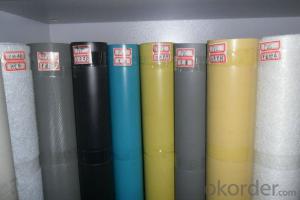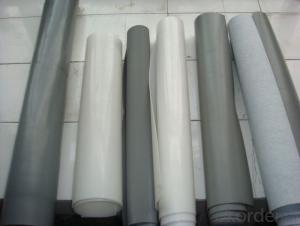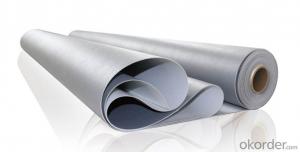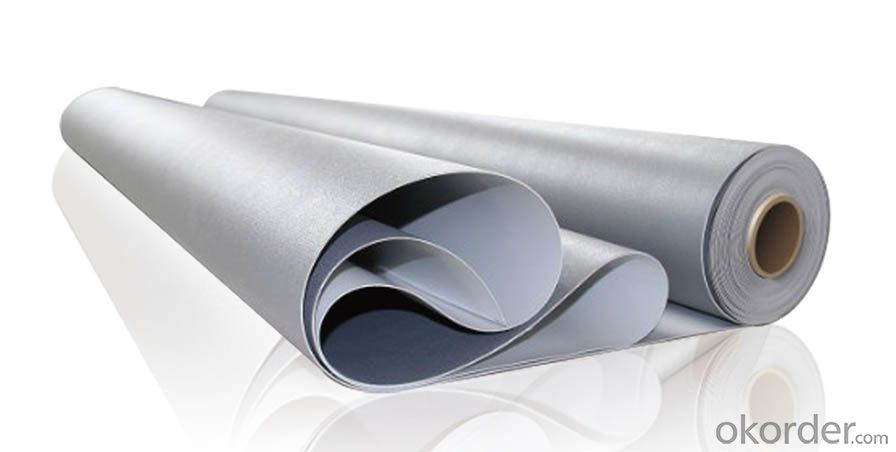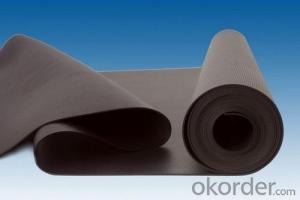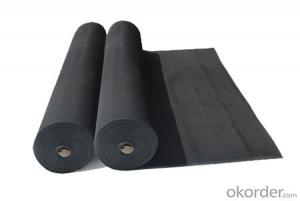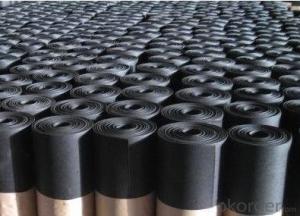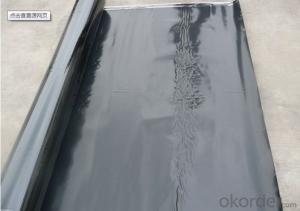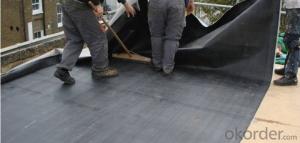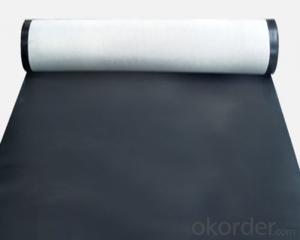EPDM Waterproof Membrane for Underground Proof
- Loading Port:
- China main port
- Payment Terms:
- TT OR LC
- Min Order Qty:
- 5000 m²
- Supply Capability:
- 100000 m²/month
OKorder Service Pledge
OKorder Financial Service
You Might Also Like
Product features:
The physical and mechanical properties of stability, durability and anti ageing capacity is good, its oil and solvent resistance and general-purpose chloroprene rubber be roughly the same.
1 Good heat resistance, cold resistance, can be in (-60-150 C) within the scope of use.
2 Extension and rate very high tear strength, shrinkage cracking of buildings or a strong ability to adapt.
3 The proportion of light (0.90~0.97), the appearance of uniform quality, has good flexibility and elasticity.
4 Good weldability, materials can be directly welded, is conducive to ensure weld quality. After welding to form an integral waterproof layer.
5 Good dimensional stability, heat shrinkage is small, the deformation is small, keep a good state during construction.
6 Environmental protection type. Does not produce harmful substances in the production, construction and use of the process, and can be recycled, does not produce construction waste.
Application range:
Applicable to all kinds of roofing, basement, tunnel, building waterproof engineering; civil and industrial building roofs and underground engineering, municipal, bridges, storage tank,
Waterproof subway, tunnel, dam engineering, especially suitable for durability, corrosion resistance requirements and easy deformation of the key waterproof engineering.
Specification of EPDM Waterproofing Membrane
1 | Breaking Tensile Strength(Room temperature) | Mpa | ≥7.5 | |
2 | Breaking Tensile Strength 60℃ | Mpa | ≥2.3 | |
3 | Breaking Elongation(Room temperature) | % | ≥450 | |
4 | Breaking Elongation(-20℃) | % | ≥200 | |
5 | Tearing strength | KN/m | ≥25 | |
6 | Impermeability, 30min no leakage | -- | 0.3Mpa no leakage | |
7 | Low temperature bending | ℃ | ≤ -40 | |
8 | Heating shrinking | Extension | mm | ≤2 |
Shrink | mm | ≤4 | ||
9 | Heat resistance (80℃x168h) | Tensile strength | % | ≥80 |
Elongation retentions | % | ≥70 | ||
10 | Alkaline resistance, Ca(OH)2 solution, room temperature x168h | Tensile strength | % | ≥80 |
Elongation retentions | % | ≥80 | ||
11 | Ozone aging(40℃x168h) | Elongation40%, 500x10-2 | -- | Non-crack |
12 | Synthetic aging | Tensile strength | % | ≥80 |
Elongation retentions | % | ≥70 | ||
FAQ of EPDM Waterproofing Membrane
a.Can we get some samples before place order?
Answer: We can send the free samples to you by freight collect.
b.How many years can your PVC membrane guarantee?
Answer: We will guarantee the quality for 5 years at least.
c.Which countries you ever export the product?
Answer: We export the PVC membrane to South Africa, Middle east and even European countries.
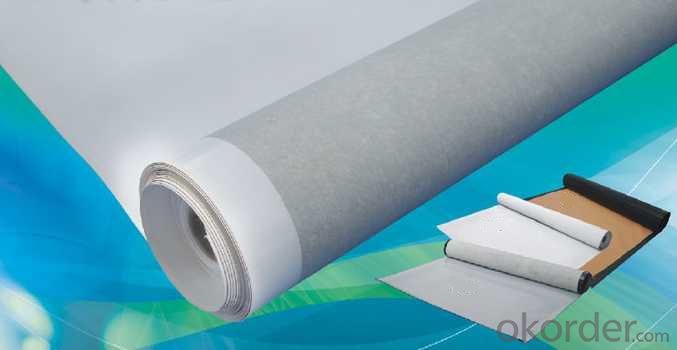
- Q: Can a waterproofing membrane be used for a shopping mall?
- Yes, a waterproofing membrane can be used for a shopping mall. A shopping mall typically has multiple levels and a large surface area, which makes it susceptible to water infiltration from rain, plumbing leaks, or other sources. Installing a waterproofing membrane can provide an effective solution to protect the structure and its contents from water damage. The membrane is typically applied to the exterior walls, roofs, and foundation of the shopping mall to create a barrier against moisture penetration. It acts as a protective layer that prevents water from seeping into the building, reducing the risk of structural damage, mold growth, and other related issues. Additionally, a properly installed waterproofing membrane can also help to improve energy efficiency by reducing heat loss and preventing water-related deterioration of insulation materials. Therefore, using a waterproofing membrane is a wise choice for ensuring the long-term durability and functionality of a shopping mall.
- Q: Can a waterproofing membrane be used on tunnels with subway systems?
- Tunnels with subway systems can indeed benefit from the use of a waterproofing membrane. It is strongly advised to incorporate this protective layer into subway tunnel construction to prevent water infiltration and potential harm to the structure and electrical systems. The waterproofing membrane acts as a barrier, effectively excluding water and safeguarding the tunnel against issues caused by moisture, such as corrosion, mold, and deterioration. It is crucial to select a waterproofing membrane that is specially designed for tunnel use and capable of withstanding the unique challenges and conditions of subway systems, including heavy traffic loads, vibrations, and exposure to chemicals. Moreover, it is essential to ensure the installation of the waterproofing membrane is carried out by experienced professionals who adhere to the appropriate guidelines and specifications, guaranteeing its effectiveness and durability.
- Q: BS waterproofing membrane is modified? There are not a few thick drawings, how to do
- For example, class Ⅱ waterproof basement waterproof, if only a SBS waterproofing membrane, then its thickness requires 4 mm; if there are other waterproof layer, you can use 3mm.
- Q: Can a waterproofing membrane be used on aerated concrete block surfaces?
- Yes, a waterproofing membrane can be used on aerated concrete block surfaces. Aerated concrete blocks are known for their porous nature, which can make them prone to water penetration. Applying a waterproofing membrane on the surface of the blocks can help prevent water from seeping through and causing damage. The membrane forms a barrier that keeps water out while still allowing the blocks to breathe and release any trapped moisture. This helps to maintain the integrity and longevity of the aerated concrete block structures. However, it is important to ensure that the waterproofing membrane is specifically designed for use on aerated concrete blocks, as different materials require different types of membrane for optimal performance.
- Q: Can a waterproofing membrane be used in bathrooms or showers?
- Yes, a waterproofing membrane can be used in bathrooms or showers. Waterproofing membranes are specifically designed to prevent water penetration and protect the underlying surfaces from moisture damage. They are commonly used in wet areas like bathrooms and showers to ensure long-lasting waterproofing and prevent water leakage.
- Q: Can waterproofing membranes be used on utility vaults?
- Utility vaults, which are commonly found underground and contain vital utility equipment like electrical transformers, water meters, and communication systems, can benefit from the use of waterproofing membranes. These structures are vulnerable to water infiltration, which can harm the equipment and disrupt its operation. To prevent water from entering utility vaults, waterproofing membranes are often employed. These membranes, typically composed of robust materials like rubber, PVC, or modified bitumen, form an impenetrable barrier against moisture. Applied to the walls and floors of the vault, they establish a tight seal that wards off any water seepage. By employing waterproofing membranes on utility vaults, the risk of water damage is significantly diminished. This safeguard ensures that the equipment housed within remains functional and undamaged for an extended period. Additionally, these membranes offer protection against other potential issues, such as leaks, corrosion, and chemical damage. However, it is crucial to note that the proper preparation of the surface and correct installation techniques are essential for a successful and enduring waterproofing system on utility vaults. Therefore, it is advisable to consult a professional waterproofing contractor with experience in working on utility vaults to achieve optimal results.
- Q: Can a waterproofing membrane be used in conjunction with solar panel installations?
- Yes, a waterproofing membrane can be used in conjunction with solar panel installations. Waterproofing membranes are commonly used to protect roofs and other surfaces from water damage, and they can provide an additional layer of protection for solar panels. This can help to prevent water infiltration and potential damage to the solar panels and their electrical components. Additionally, waterproofing membranes can also help to extend the lifespan of the solar panel system by providing an extra barrier against moisture and other environmental factors.
- Q: Can a waterproofing membrane prevent leaks from occurring?
- Preventing leaks is indeed possible with the use of a waterproofing membrane. This membrane is a thin material layer that, when applied to a surface, renders it completely impervious to water. Its purpose is to serve as a barrier, effectively stopping water from seeping through and causing any leaks. With correct installation and ongoing maintenance, a waterproofing membrane can provide reliable protection against water damage for a variety of structures, such as roofs, basements, bathrooms, and foundations. It is specifically designed to withstand the forces of nature, including rain, snow, and moisture, thus greatly reducing the likelihood of leaks and water infiltration. However, it is worth noting that the efficacy of a waterproofing membrane also relies on the quality of the product, proper installation procedures, and regular maintenance.
- Q: Can a waterproofing membrane be used for parking garages?
- Yes, a waterproofing membrane can be used for parking garages. Waterproofing membranes are commonly used in construction to prevent water infiltration and damage to structures. Given the potential exposure of parking garages to water from rainfall, snowmelt, or vehicle fluids, using a waterproofing membrane can help protect the structural integrity of the garage and extend its lifespan.
- Q: Can a waterproofing membrane be used in showers and wet areas?
- Yes, a waterproofing membrane can definitely be used in showers and wet areas. In fact, it is highly recommended to install a waterproofing membrane in these areas to prevent water damage and leakage. A waterproofing membrane acts as a barrier between the tile or flooring and the subfloor, ensuring that any water that seeps through the surface is contained and directed towards the drains. This helps to protect the underlying structure from moisture damage, such as rotting or mold growth. Additionally, a waterproofing membrane can also help to reduce the risk of water seeping into adjacent areas and causing damage to nearby walls or floors. It is important to ensure that the waterproofing membrane is installed correctly and that all seams, corners, and penetrations are properly sealed to achieve the desired level of waterproofing.
Send your message to us
EPDM Waterproof Membrane for Underground Proof
- Loading Port:
- China main port
- Payment Terms:
- TT OR LC
- Min Order Qty:
- 5000 m²
- Supply Capability:
- 100000 m²/month
OKorder Service Pledge
OKorder Financial Service
Similar products
Hot products
Hot Searches
Related keywords
